NUR231 Drug Therapy: Safe Medication Practice for Type 1 Diabetes
VerifiedAdded on 2023/06/10
|9
|3239
|337
Practical Assignment
AI Summary
This assignment explores drug therapy for managing type 1 diabetes, focusing on a case study of a 19-year-old patient named Jarrah Barrett. Part A provides professional-focused information, covering the pathophysiology of type 1 diabetes, the rationale for insulin treatment over oral medications, and the time-course and mechanisms of action of insulin aspart (NovoRapid) and insulin glargine (Optisulin). It also addresses the nurse's responsibilities in managing hypoglycemic episodes, referencing the Nursing and Midwifery Board of Australia (NMBA) standards. Part B shifts to person-centered care, emphasizing patient education on the long-term benefits of insulin, recognizing hypoglycemia symptoms, and proper insulin self-administration techniques. The assignment integrates the ACQHS Quality Use of Medicines principles and NMBA Registered Nurse Standards for Practice, aiming to enhance patient control over their health.
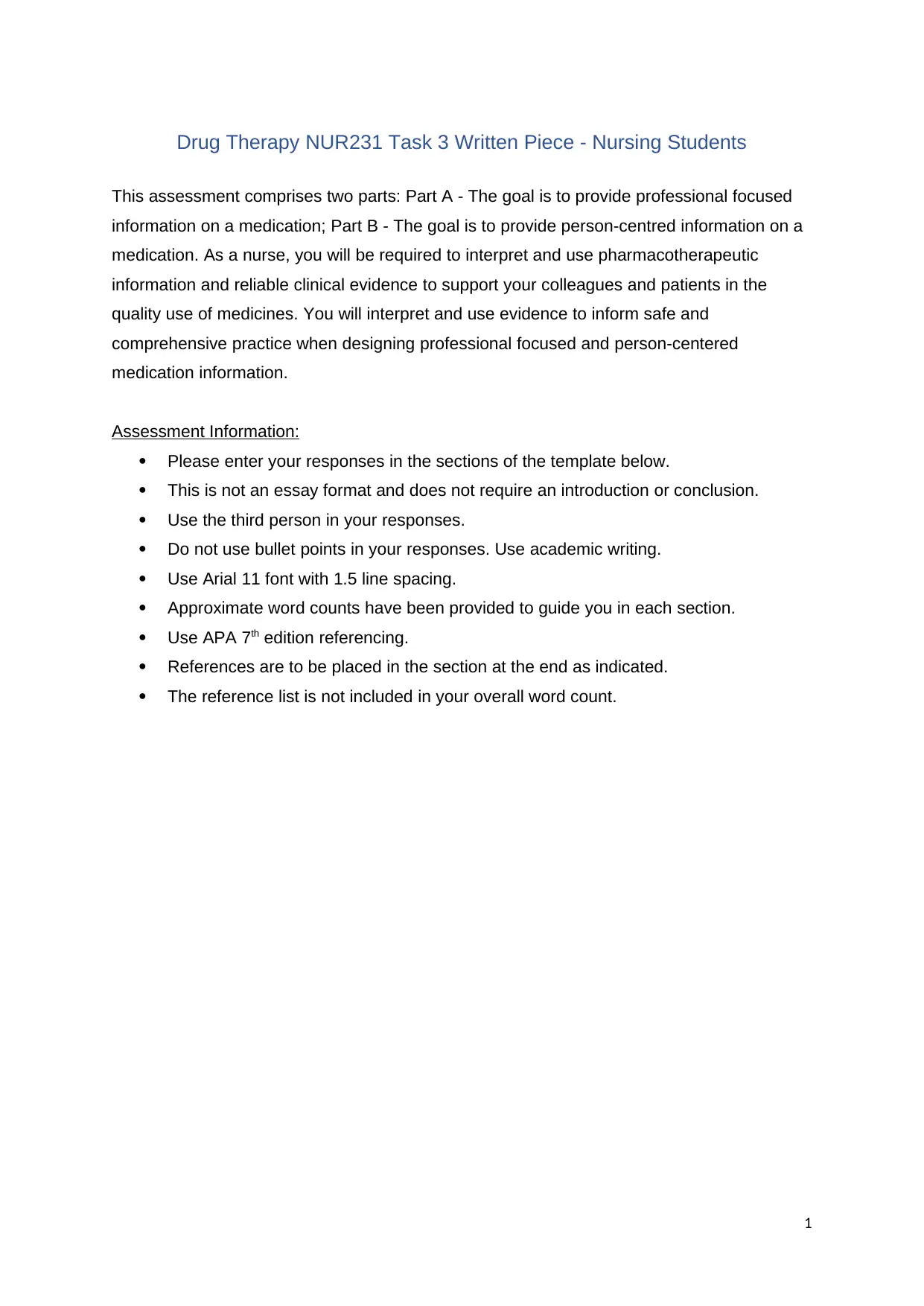
Drug Therapy NUR231 Task 3 Written Piece - Nursing Students
This assessment comprises two parts: Part A - The goal is to provide professional focused
information on a medication; Part B - The goal is to provide person-centred information on a
medication. As a nurse, you will be required to interpret and use pharmacotherapeutic
information and reliable clinical evidence to support your colleagues and patients in the
quality use of medicines. You will interpret and use evidence to inform safe and
comprehensive practice when designing professional focused and person-centered
medication information.
Assessment Information:
Please enter your responses in the sections of the template below.
This is not an essay format and does not require an introduction or conclusion.
Use the third person in your responses.
Do not use bullet points in your responses. Use academic writing.
Use Arial 11 font with 1.5 line spacing.
Approximate word counts have been provided to guide you in each section.
Use APA 7th edition referencing.
References are to be placed in the section at the end as indicated.
The reference list is not included in your overall word count.
1
This assessment comprises two parts: Part A - The goal is to provide professional focused
information on a medication; Part B - The goal is to provide person-centred information on a
medication. As a nurse, you will be required to interpret and use pharmacotherapeutic
information and reliable clinical evidence to support your colleagues and patients in the
quality use of medicines. You will interpret and use evidence to inform safe and
comprehensive practice when designing professional focused and person-centered
medication information.
Assessment Information:
Please enter your responses in the sections of the template below.
This is not an essay format and does not require an introduction or conclusion.
Use the third person in your responses.
Do not use bullet points in your responses. Use academic writing.
Use Arial 11 font with 1.5 line spacing.
Approximate word counts have been provided to guide you in each section.
Use APA 7th edition referencing.
References are to be placed in the section at the end as indicated.
The reference list is not included in your overall word count.
1
Paraphrase This Document
Need a fresh take? Get an instant paraphrase of this document with our AI Paraphraser
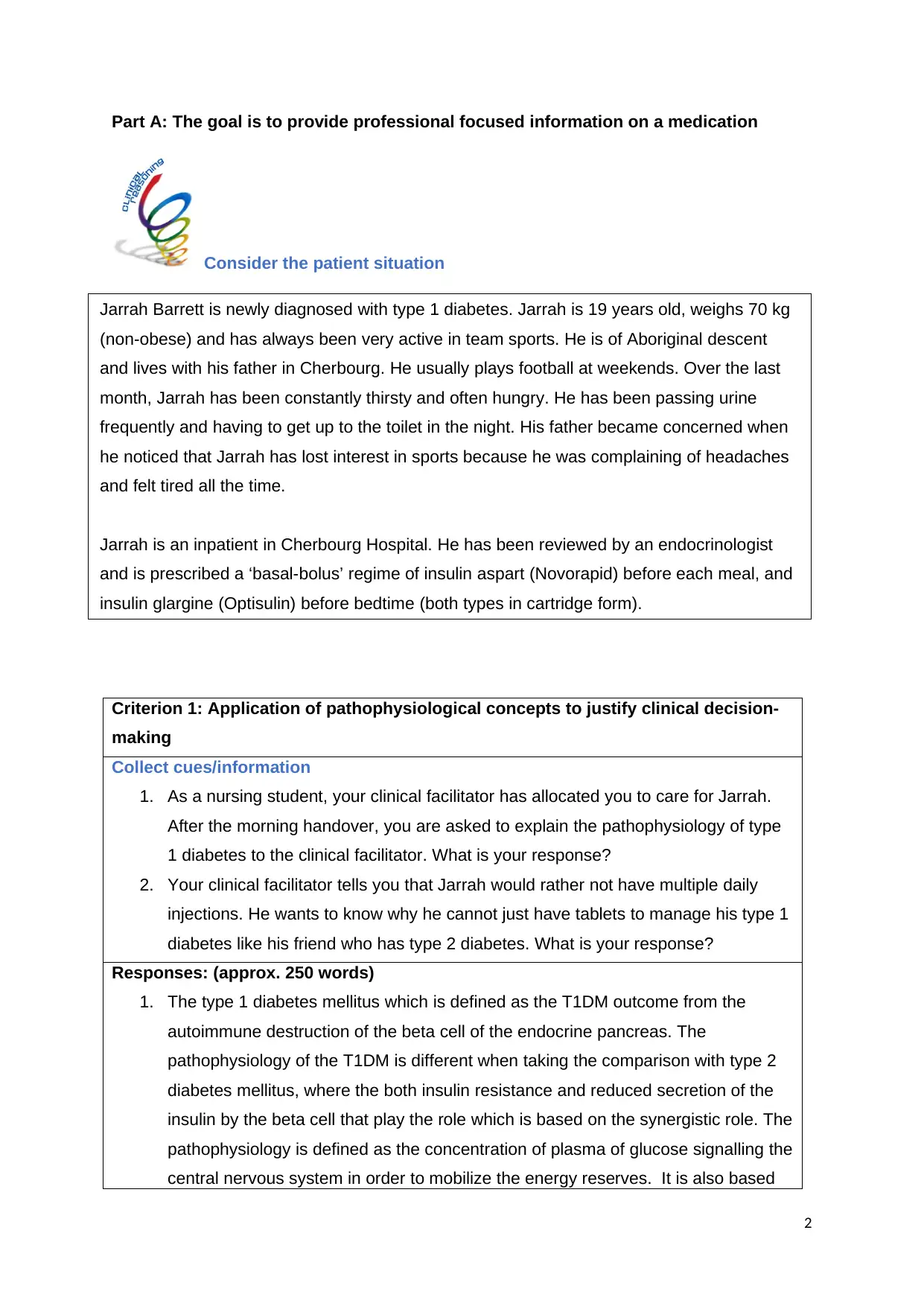
Part A: The goal is to provide professional focused information on a medication
Consider the patient situation
Criterion 1: Application of pathophysiological concepts to justify clinical decision-
making
Collect cues/information
1. As a nursing student, your clinical facilitator has allocated you to care for Jarrah.
After the morning handover, you are asked to explain the pathophysiology of type
1 diabetes to the clinical facilitator. What is your response?
2. Your clinical facilitator tells you that Jarrah would rather not have multiple daily
injections. He wants to know why he cannot just have tablets to manage his type 1
diabetes like his friend who has type 2 diabetes. What is your response?
Responses: (approx. 250 words)
1. The type 1 diabetes mellitus which is defined as the T1DM outcome from the
autoimmune destruction of the beta cell of the endocrine pancreas. The
pathophysiology of the T1DM is different when taking the comparison with type 2
diabetes mellitus, where the both insulin resistance and reduced secretion of the
insulin by the beta cell that play the role which is based on the synergistic role. The
pathophysiology is defined as the concentration of plasma of glucose signalling the
central nervous system in order to mobilize the energy reserves. It is also based
2
Jarrah Barrett is newly diagnosed with type 1 diabetes. Jarrah is 19 years old, weighs 70 kg
(non-obese) and has always been very active in team sports. He is of Aboriginal descent
and lives with his father in Cherbourg. He usually plays football at weekends. Over the last
month, Jarrah has been constantly thirsty and often hungry. He has been passing urine
frequently and having to get up to the toilet in the night. His father became concerned when
he noticed that Jarrah has lost interest in sports because he was complaining of headaches
and felt tired all the time.
Jarrah is an inpatient in Cherbourg Hospital. He has been reviewed by an endocrinologist
and is prescribed a ‘basal-bolus’ regime of insulin aspart (Novorapid) before each meal, and
insulin glargine (Optisulin) before bedtime (both types in cartridge form).
Consider the patient situation
Criterion 1: Application of pathophysiological concepts to justify clinical decision-
making
Collect cues/information
1. As a nursing student, your clinical facilitator has allocated you to care for Jarrah.
After the morning handover, you are asked to explain the pathophysiology of type
1 diabetes to the clinical facilitator. What is your response?
2. Your clinical facilitator tells you that Jarrah would rather not have multiple daily
injections. He wants to know why he cannot just have tablets to manage his type 1
diabetes like his friend who has type 2 diabetes. What is your response?
Responses: (approx. 250 words)
1. The type 1 diabetes mellitus which is defined as the T1DM outcome from the
autoimmune destruction of the beta cell of the endocrine pancreas. The
pathophysiology of the T1DM is different when taking the comparison with type 2
diabetes mellitus, where the both insulin resistance and reduced secretion of the
insulin by the beta cell that play the role which is based on the synergistic role. The
pathophysiology is defined as the concentration of plasma of glucose signalling the
central nervous system in order to mobilize the energy reserves. It is also based
2
Jarrah Barrett is newly diagnosed with type 1 diabetes. Jarrah is 19 years old, weighs 70 kg
(non-obese) and has always been very active in team sports. He is of Aboriginal descent
and lives with his father in Cherbourg. He usually plays football at weekends. Over the last
month, Jarrah has been constantly thirsty and often hungry. He has been passing urine
frequently and having to get up to the toilet in the night. His father became concerned when
he noticed that Jarrah has lost interest in sports because he was complaining of headaches
and felt tired all the time.
Jarrah is an inpatient in Cherbourg Hospital. He has been reviewed by an endocrinologist
and is prescribed a ‘basal-bolus’ regime of insulin aspart (Novorapid) before each meal, and
insulin glargine (Optisulin) before bedtime (both types in cartridge form).
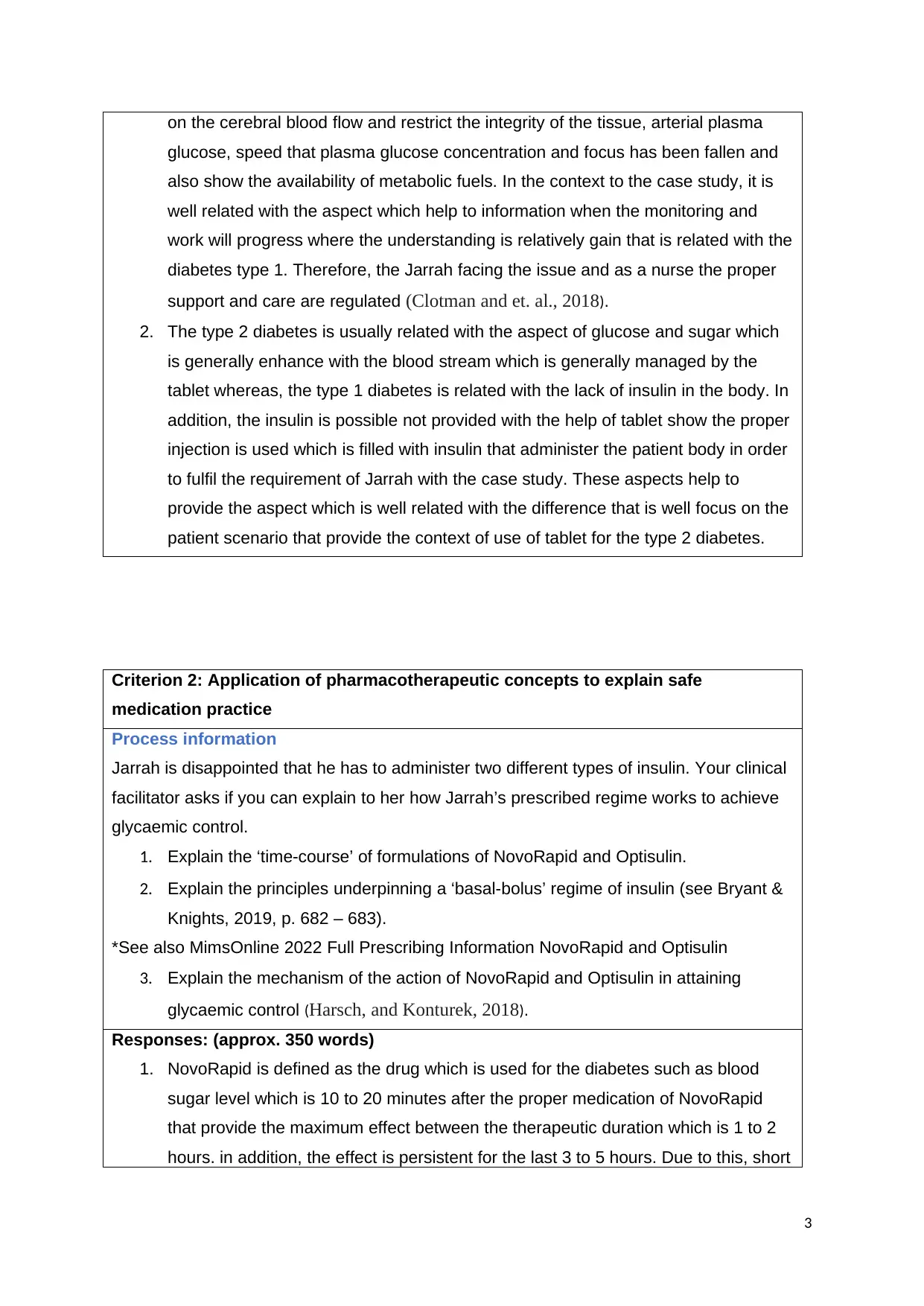
on the cerebral blood flow and restrict the integrity of the tissue, arterial plasma
glucose, speed that plasma glucose concentration and focus has been fallen and
also show the availability of metabolic fuels. In the context to the case study, it is
well related with the aspect which help to information when the monitoring and
work will progress where the understanding is relatively gain that is related with the
diabetes type 1. Therefore, the Jarrah facing the issue and as a nurse the proper
support and care are regulated (Clotman and et. al., 2018).
2. The type 2 diabetes is usually related with the aspect of glucose and sugar which
is generally enhance with the blood stream which is generally managed by the
tablet whereas, the type 1 diabetes is related with the lack of insulin in the body. In
addition, the insulin is possible not provided with the help of tablet show the proper
injection is used which is filled with insulin that administer the patient body in order
to fulfil the requirement of Jarrah with the case study. These aspects help to
provide the aspect which is well related with the difference that is well focus on the
patient scenario that provide the context of use of tablet for the type 2 diabetes.
Criterion 2: Application of pharmacotherapeutic concepts to explain safe
medication practice
Process information
Jarrah is disappointed that he has to administer two different types of insulin. Your clinical
facilitator asks if you can explain to her how Jarrah’s prescribed regime works to achieve
glycaemic control.
1. Explain the ‘time-course’ of formulations of NovoRapid and Optisulin.
2. Explain the principles underpinning a ‘basal-bolus’ regime of insulin (see Bryant &
Knights, 2019, p. 682 – 683).
*See also MimsOnline 2022 Full Prescribing Information NovoRapid and Optisulin
3. Explain the mechanism of the action of NovoRapid and Optisulin in attaining
glycaemic control (Harsch, and Konturek, 2018).
Responses: (approx. 350 words)
1. NovoRapid is defined as the drug which is used for the diabetes such as blood
sugar level which is 10 to 20 minutes after the proper medication of NovoRapid
that provide the maximum effect between the therapeutic duration which is 1 to 2
hours. in addition, the effect is persistent for the last 3 to 5 hours. Due to this, short
3
glucose, speed that plasma glucose concentration and focus has been fallen and
also show the availability of metabolic fuels. In the context to the case study, it is
well related with the aspect which help to information when the monitoring and
work will progress where the understanding is relatively gain that is related with the
diabetes type 1. Therefore, the Jarrah facing the issue and as a nurse the proper
support and care are regulated (Clotman and et. al., 2018).
2. The type 2 diabetes is usually related with the aspect of glucose and sugar which
is generally enhance with the blood stream which is generally managed by the
tablet whereas, the type 1 diabetes is related with the lack of insulin in the body. In
addition, the insulin is possible not provided with the help of tablet show the proper
injection is used which is filled with insulin that administer the patient body in order
to fulfil the requirement of Jarrah with the case study. These aspects help to
provide the aspect which is well related with the difference that is well focus on the
patient scenario that provide the context of use of tablet for the type 2 diabetes.
Criterion 2: Application of pharmacotherapeutic concepts to explain safe
medication practice
Process information
Jarrah is disappointed that he has to administer two different types of insulin. Your clinical
facilitator asks if you can explain to her how Jarrah’s prescribed regime works to achieve
glycaemic control.
1. Explain the ‘time-course’ of formulations of NovoRapid and Optisulin.
2. Explain the principles underpinning a ‘basal-bolus’ regime of insulin (see Bryant &
Knights, 2019, p. 682 – 683).
*See also MimsOnline 2022 Full Prescribing Information NovoRapid and Optisulin
3. Explain the mechanism of the action of NovoRapid and Optisulin in attaining
glycaemic control (Harsch, and Konturek, 2018).
Responses: (approx. 350 words)
1. NovoRapid is defined as the drug which is used for the diabetes such as blood
sugar level which is 10 to 20 minutes after the proper medication of NovoRapid
that provide the maximum effect between the therapeutic duration which is 1 to 2
hours. in addition, the effect is persistent for the last 3 to 5 hours. Due to this, short
3
⊘ This is a preview!⊘
Do you want full access?
Subscribe today to unlock all pages.

Trusted by 1+ million students worldwide
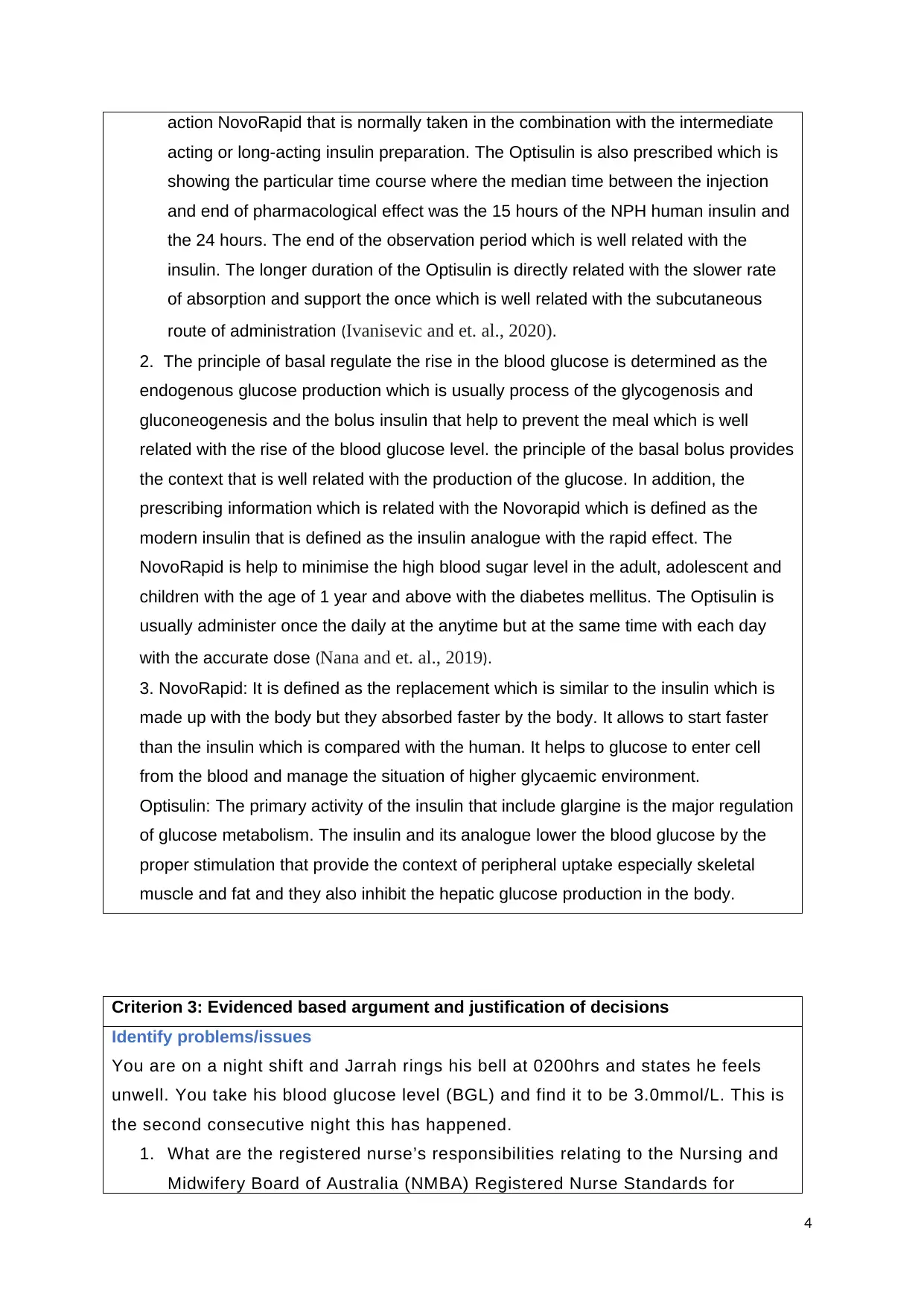
action NovoRapid that is normally taken in the combination with the intermediate
acting or long-acting insulin preparation. The Optisulin is also prescribed which is
showing the particular time course where the median time between the injection
and end of pharmacological effect was the 15 hours of the NPH human insulin and
the 24 hours. The end of the observation period which is well related with the
insulin. The longer duration of the Optisulin is directly related with the slower rate
of absorption and support the once which is well related with the subcutaneous
route of administration (Ivanisevic and et. al., 2020).
2. The principle of basal regulate the rise in the blood glucose is determined as the
endogenous glucose production which is usually process of the glycogenosis and
gluconeogenesis and the bolus insulin that help to prevent the meal which is well
related with the rise of the blood glucose level. the principle of the basal bolus provides
the context that is well related with the production of the glucose. In addition, the
prescribing information which is related with the Novorapid which is defined as the
modern insulin that is defined as the insulin analogue with the rapid effect. The
NovoRapid is help to minimise the high blood sugar level in the adult, adolescent and
children with the age of 1 year and above with the diabetes mellitus. The Optisulin is
usually administer once the daily at the anytime but at the same time with each day
with the accurate dose (Nana and et. al., 2019).
3. NovoRapid: It is defined as the replacement which is similar to the insulin which is
made up with the body but they absorbed faster by the body. It allows to start faster
than the insulin which is compared with the human. It helps to glucose to enter cell
from the blood and manage the situation of higher glycaemic environment.
Optisulin: The primary activity of the insulin that include glargine is the major regulation
of glucose metabolism. The insulin and its analogue lower the blood glucose by the
proper stimulation that provide the context of peripheral uptake especially skeletal
muscle and fat and they also inhibit the hepatic glucose production in the body.
Criterion 3: Evidenced based argument and justification of decisions
Identify problems/issues
You are on a night shift and Jarrah rings his bell at 0200hrs and states he feels
unwell. You take his blood glucose level (BGL) and find it to be 3.0mmol/L. This is
the second consecutive night this has happened.
1. What are the registered nurse’s responsibilities relating to the Nursing and
Midwifery Board of Australia (NMBA) Registered Nurse Standards for
4
acting or long-acting insulin preparation. The Optisulin is also prescribed which is
showing the particular time course where the median time between the injection
and end of pharmacological effect was the 15 hours of the NPH human insulin and
the 24 hours. The end of the observation period which is well related with the
insulin. The longer duration of the Optisulin is directly related with the slower rate
of absorption and support the once which is well related with the subcutaneous
route of administration (Ivanisevic and et. al., 2020).
2. The principle of basal regulate the rise in the blood glucose is determined as the
endogenous glucose production which is usually process of the glycogenosis and
gluconeogenesis and the bolus insulin that help to prevent the meal which is well
related with the rise of the blood glucose level. the principle of the basal bolus provides
the context that is well related with the production of the glucose. In addition, the
prescribing information which is related with the Novorapid which is defined as the
modern insulin that is defined as the insulin analogue with the rapid effect. The
NovoRapid is help to minimise the high blood sugar level in the adult, adolescent and
children with the age of 1 year and above with the diabetes mellitus. The Optisulin is
usually administer once the daily at the anytime but at the same time with each day
with the accurate dose (Nana and et. al., 2019).
3. NovoRapid: It is defined as the replacement which is similar to the insulin which is
made up with the body but they absorbed faster by the body. It allows to start faster
than the insulin which is compared with the human. It helps to glucose to enter cell
from the blood and manage the situation of higher glycaemic environment.
Optisulin: The primary activity of the insulin that include glargine is the major regulation
of glucose metabolism. The insulin and its analogue lower the blood glucose by the
proper stimulation that provide the context of peripheral uptake especially skeletal
muscle and fat and they also inhibit the hepatic glucose production in the body.
Criterion 3: Evidenced based argument and justification of decisions
Identify problems/issues
You are on a night shift and Jarrah rings his bell at 0200hrs and states he feels
unwell. You take his blood glucose level (BGL) and find it to be 3.0mmol/L. This is
the second consecutive night this has happened.
1. What are the registered nurse’s responsibilities relating to the Nursing and
Midwifery Board of Australia (NMBA) Registered Nurse Standards for
4
Paraphrase This Document
Need a fresh take? Get an instant paraphrase of this document with our AI Paraphraser
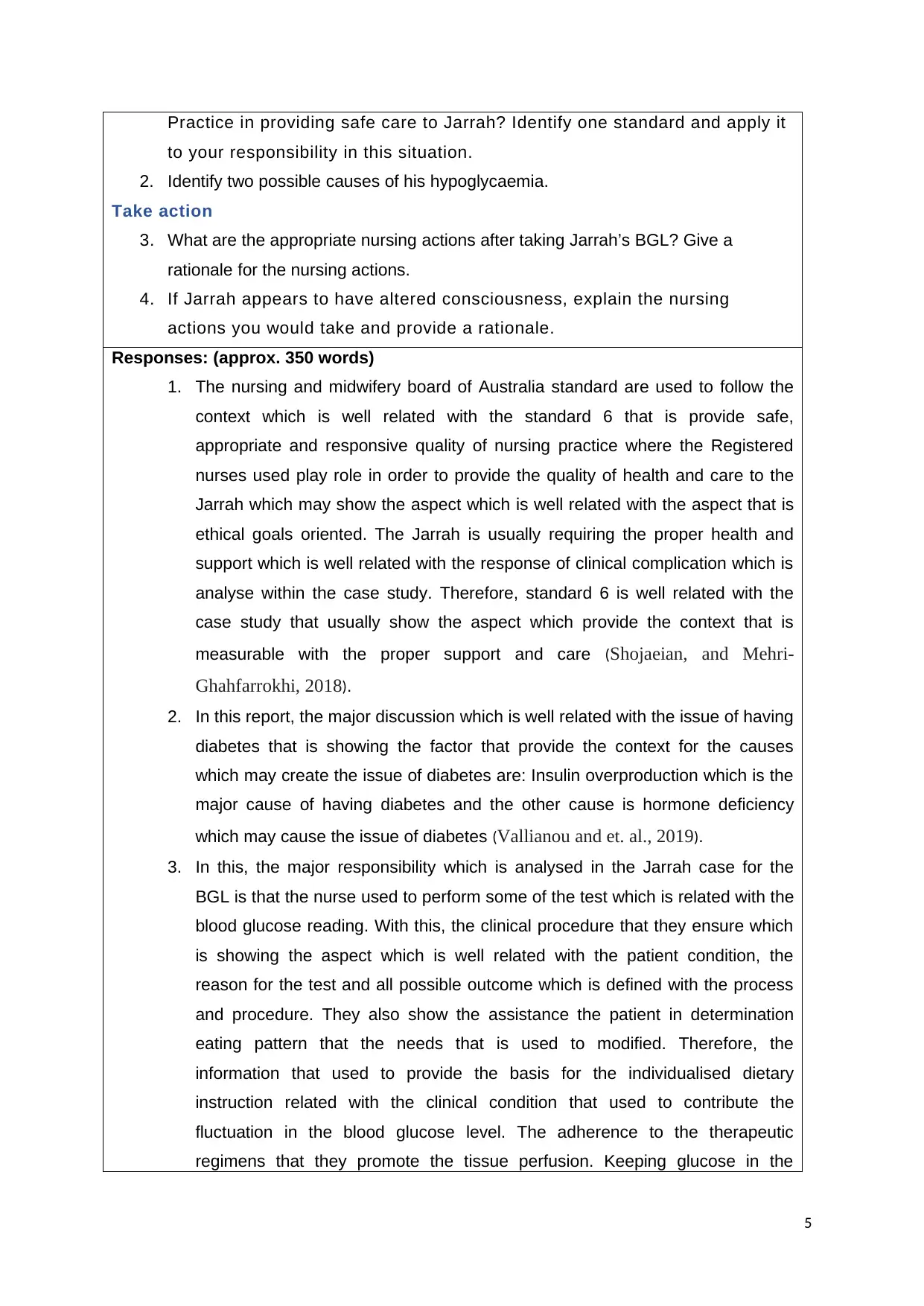
Practice in providing safe care to Jarrah? Identify one standard and apply it
to your responsibility in this situation.
2. Identify two possible causes of his hypoglycaemia.
Take action
3. What are the appropriate nursing actions after taking Jarrah’s BGL? Give a
rationale for the nursing actions.
4. If Jarrah appears to have altered consciousness, explain the nursing
actions you would take and provide a rationale.
Responses: (approx. 350 words)
1. The nursing and midwifery board of Australia standard are used to follow the
context which is well related with the standard 6 that is provide safe,
appropriate and responsive quality of nursing practice where the Registered
nurses used play role in order to provide the quality of health and care to the
Jarrah which may show the aspect which is well related with the aspect that is
ethical goals oriented. The Jarrah is usually requiring the proper health and
support which is well related with the response of clinical complication which is
analyse within the case study. Therefore, standard 6 is well related with the
case study that usually show the aspect which provide the context that is
measurable with the proper support and care (Shojaeian, and Mehri-
Ghahfarrokhi, 2018).
2. In this report, the major discussion which is well related with the issue of having
diabetes that is showing the factor that provide the context for the causes
which may create the issue of diabetes are: Insulin overproduction which is the
major cause of having diabetes and the other cause is hormone deficiency
which may cause the issue of diabetes (Vallianou and et. al., 2019).
3. In this, the major responsibility which is analysed in the Jarrah case for the
BGL is that the nurse used to perform some of the test which is related with the
blood glucose reading. With this, the clinical procedure that they ensure which
is showing the aspect which is well related with the patient condition, the
reason for the test and all possible outcome which is defined with the process
and procedure. They also show the assistance the patient in determination
eating pattern that the needs that is used to modified. Therefore, the
information that used to provide the basis for the individualised dietary
instruction related with the clinical condition that used to contribute the
fluctuation in the blood glucose level. The adherence to the therapeutic
regimens that they promote the tissue perfusion. Keeping glucose in the
5
to your responsibility in this situation.
2. Identify two possible causes of his hypoglycaemia.
Take action
3. What are the appropriate nursing actions after taking Jarrah’s BGL? Give a
rationale for the nursing actions.
4. If Jarrah appears to have altered consciousness, explain the nursing
actions you would take and provide a rationale.
Responses: (approx. 350 words)
1. The nursing and midwifery board of Australia standard are used to follow the
context which is well related with the standard 6 that is provide safe,
appropriate and responsive quality of nursing practice where the Registered
nurses used play role in order to provide the quality of health and care to the
Jarrah which may show the aspect which is well related with the aspect that is
ethical goals oriented. The Jarrah is usually requiring the proper health and
support which is well related with the response of clinical complication which is
analyse within the case study. Therefore, standard 6 is well related with the
case study that usually show the aspect which provide the context that is
measurable with the proper support and care (Shojaeian, and Mehri-
Ghahfarrokhi, 2018).
2. In this report, the major discussion which is well related with the issue of having
diabetes that is showing the factor that provide the context for the causes
which may create the issue of diabetes are: Insulin overproduction which is the
major cause of having diabetes and the other cause is hormone deficiency
which may cause the issue of diabetes (Vallianou and et. al., 2019).
3. In this, the major responsibility which is analysed in the Jarrah case for the
BGL is that the nurse used to perform some of the test which is related with the
blood glucose reading. With this, the clinical procedure that they ensure which
is showing the aspect which is well related with the patient condition, the
reason for the test and all possible outcome which is defined with the process
and procedure. They also show the assistance the patient in determination
eating pattern that the needs that is used to modified. Therefore, the
information that used to provide the basis for the individualised dietary
instruction related with the clinical condition that used to contribute the
fluctuation in the blood glucose level. The adherence to the therapeutic
regimens that they promote the tissue perfusion. Keeping glucose in the
5
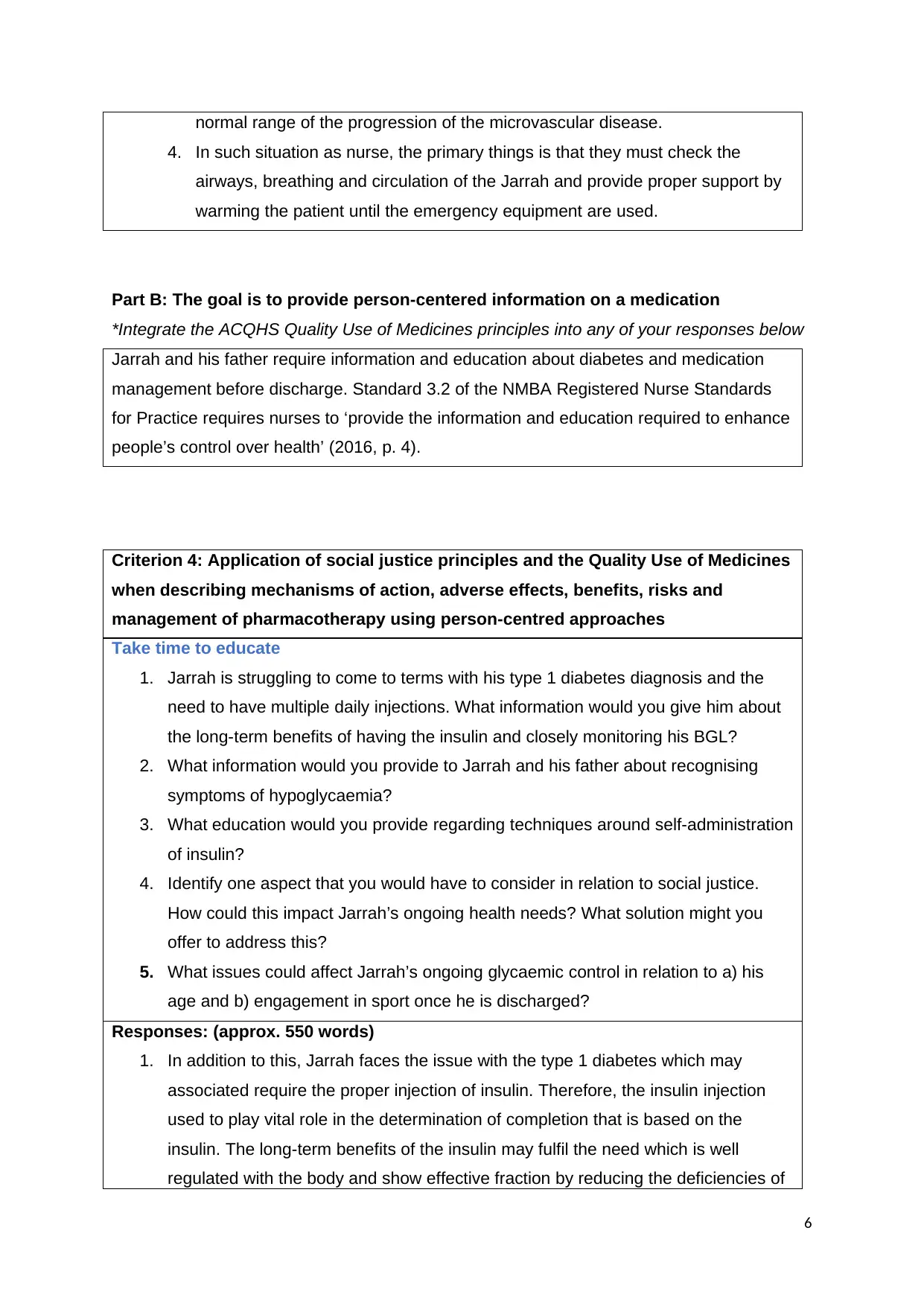
normal range of the progression of the microvascular disease.
4. In such situation as nurse, the primary things is that they must check the
airways, breathing and circulation of the Jarrah and provide proper support by
warming the patient until the emergency equipment are used.
Part B: The goal is to provide person-centered information on a medication
*Integrate the ACQHS Quality Use of Medicines principles into any of your responses below
Jarrah and his father require information and education about diabetes and medication
management before discharge. Standard 3.2 of the NMBA Registered Nurse Standards
for Practice requires nurses to ‘provide the information and education required to enhance
people’s control over health’ (2016, p. 4).
Criterion 4: Application of social justice principles and the Quality Use of Medicines
when describing mechanisms of action, adverse effects, benefits, risks and
management of pharmacotherapy using person-centred approaches
Take time to educate
1. Jarrah is struggling to come to terms with his type 1 diabetes diagnosis and the
need to have multiple daily injections. What information would you give him about
the long-term benefits of having the insulin and closely monitoring his BGL?
2. What information would you provide to Jarrah and his father about recognising
symptoms of hypoglycaemia?
3. What education would you provide regarding techniques around self-administration
of insulin?
4. Identify one aspect that you would have to consider in relation to social justice.
How could this impact Jarrah’s ongoing health needs? What solution might you
offer to address this?
5. What issues could affect Jarrah’s ongoing glycaemic control in relation to a) his
age and b) engagement in sport once he is discharged?
Responses: (approx. 550 words)
1. In addition to this, Jarrah faces the issue with the type 1 diabetes which may
associated require the proper injection of insulin. Therefore, the insulin injection
used to play vital role in the determination of completion that is based on the
insulin. The long-term benefits of the insulin may fulfil the need which is well
regulated with the body and show effective fraction by reducing the deficiencies of
6
4. In such situation as nurse, the primary things is that they must check the
airways, breathing and circulation of the Jarrah and provide proper support by
warming the patient until the emergency equipment are used.
Part B: The goal is to provide person-centered information on a medication
*Integrate the ACQHS Quality Use of Medicines principles into any of your responses below
Jarrah and his father require information and education about diabetes and medication
management before discharge. Standard 3.2 of the NMBA Registered Nurse Standards
for Practice requires nurses to ‘provide the information and education required to enhance
people’s control over health’ (2016, p. 4).
Criterion 4: Application of social justice principles and the Quality Use of Medicines
when describing mechanisms of action, adverse effects, benefits, risks and
management of pharmacotherapy using person-centred approaches
Take time to educate
1. Jarrah is struggling to come to terms with his type 1 diabetes diagnosis and the
need to have multiple daily injections. What information would you give him about
the long-term benefits of having the insulin and closely monitoring his BGL?
2. What information would you provide to Jarrah and his father about recognising
symptoms of hypoglycaemia?
3. What education would you provide regarding techniques around self-administration
of insulin?
4. Identify one aspect that you would have to consider in relation to social justice.
How could this impact Jarrah’s ongoing health needs? What solution might you
offer to address this?
5. What issues could affect Jarrah’s ongoing glycaemic control in relation to a) his
age and b) engagement in sport once he is discharged?
Responses: (approx. 550 words)
1. In addition to this, Jarrah faces the issue with the type 1 diabetes which may
associated require the proper injection of insulin. Therefore, the insulin injection
used to play vital role in the determination of completion that is based on the
insulin. The long-term benefits of the insulin may fulfil the need which is well
regulated with the body and show effective fraction by reducing the deficiencies of
6
⊘ This is a preview!⊘
Do you want full access?
Subscribe today to unlock all pages.

Trusted by 1+ million students worldwide
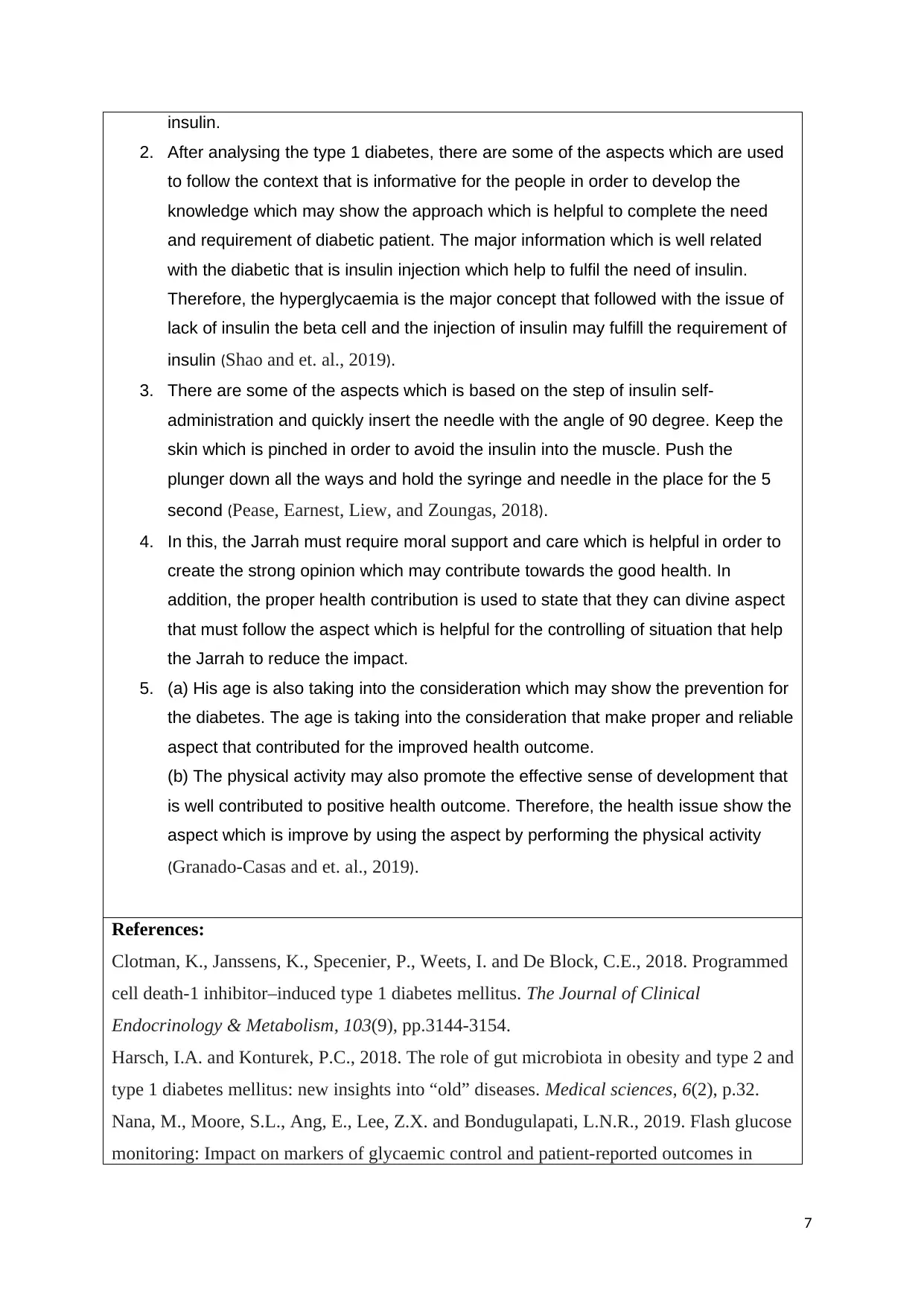
insulin.
2. After analysing the type 1 diabetes, there are some of the aspects which are used
to follow the context that is informative for the people in order to develop the
knowledge which may show the approach which is helpful to complete the need
and requirement of diabetic patient. The major information which is well related
with the diabetic that is insulin injection which help to fulfil the need of insulin.
Therefore, the hyperglycaemia is the major concept that followed with the issue of
lack of insulin the beta cell and the injection of insulin may fulfill the requirement of
insulin (Shao and et. al., 2019).
3. There are some of the aspects which is based on the step of insulin self-
administration and quickly insert the needle with the angle of 90 degree. Keep the
skin which is pinched in order to avoid the insulin into the muscle. Push the
plunger down all the ways and hold the syringe and needle in the place for the 5
second (Pease, Earnest, Liew, and Zoungas, 2018).
4. In this, the Jarrah must require moral support and care which is helpful in order to
create the strong opinion which may contribute towards the good health. In
addition, the proper health contribution is used to state that they can divine aspect
that must follow the aspect which is helpful for the controlling of situation that help
the Jarrah to reduce the impact.
5. (a) His age is also taking into the consideration which may show the prevention for
the diabetes. The age is taking into the consideration that make proper and reliable
aspect that contributed for the improved health outcome.
(b) The physical activity may also promote the effective sense of development that
is well contributed to positive health outcome. Therefore, the health issue show the
aspect which is improve by using the aspect by performing the physical activity
(Granado-Casas and et. al., 2019).
References:
Clotman, K., Janssens, K., Specenier, P., Weets, I. and De Block, C.E., 2018. Programmed
cell death-1 inhibitor–induced type 1 diabetes mellitus. The Journal of Clinical
Endocrinology & Metabolism, 103(9), pp.3144-3154.
Harsch, I.A. and Konturek, P.C., 2018. The role of gut microbiota in obesity and type 2 and
type 1 diabetes mellitus: new insights into “old” diseases. Medical sciences, 6(2), p.32.
Nana, M., Moore, S.L., Ang, E., Lee, Z.X. and Bondugulapati, L.N.R., 2019. Flash glucose
monitoring: Impact on markers of glycaemic control and patient-reported outcomes in
7
2. After analysing the type 1 diabetes, there are some of the aspects which are used
to follow the context that is informative for the people in order to develop the
knowledge which may show the approach which is helpful to complete the need
and requirement of diabetic patient. The major information which is well related
with the diabetic that is insulin injection which help to fulfil the need of insulin.
Therefore, the hyperglycaemia is the major concept that followed with the issue of
lack of insulin the beta cell and the injection of insulin may fulfill the requirement of
insulin (Shao and et. al., 2019).
3. There are some of the aspects which is based on the step of insulin self-
administration and quickly insert the needle with the angle of 90 degree. Keep the
skin which is pinched in order to avoid the insulin into the muscle. Push the
plunger down all the ways and hold the syringe and needle in the place for the 5
second (Pease, Earnest, Liew, and Zoungas, 2018).
4. In this, the Jarrah must require moral support and care which is helpful in order to
create the strong opinion which may contribute towards the good health. In
addition, the proper health contribution is used to state that they can divine aspect
that must follow the aspect which is helpful for the controlling of situation that help
the Jarrah to reduce the impact.
5. (a) His age is also taking into the consideration which may show the prevention for
the diabetes. The age is taking into the consideration that make proper and reliable
aspect that contributed for the improved health outcome.
(b) The physical activity may also promote the effective sense of development that
is well contributed to positive health outcome. Therefore, the health issue show the
aspect which is improve by using the aspect by performing the physical activity
(Granado-Casas and et. al., 2019).
References:
Clotman, K., Janssens, K., Specenier, P., Weets, I. and De Block, C.E., 2018. Programmed
cell death-1 inhibitor–induced type 1 diabetes mellitus. The Journal of Clinical
Endocrinology & Metabolism, 103(9), pp.3144-3154.
Harsch, I.A. and Konturek, P.C., 2018. The role of gut microbiota in obesity and type 2 and
type 1 diabetes mellitus: new insights into “old” diseases. Medical sciences, 6(2), p.32.
Nana, M., Moore, S.L., Ang, E., Lee, Z.X. and Bondugulapati, L.N.R., 2019. Flash glucose
monitoring: Impact on markers of glycaemic control and patient-reported outcomes in
7
Paraphrase This Document
Need a fresh take? Get an instant paraphrase of this document with our AI Paraphraser
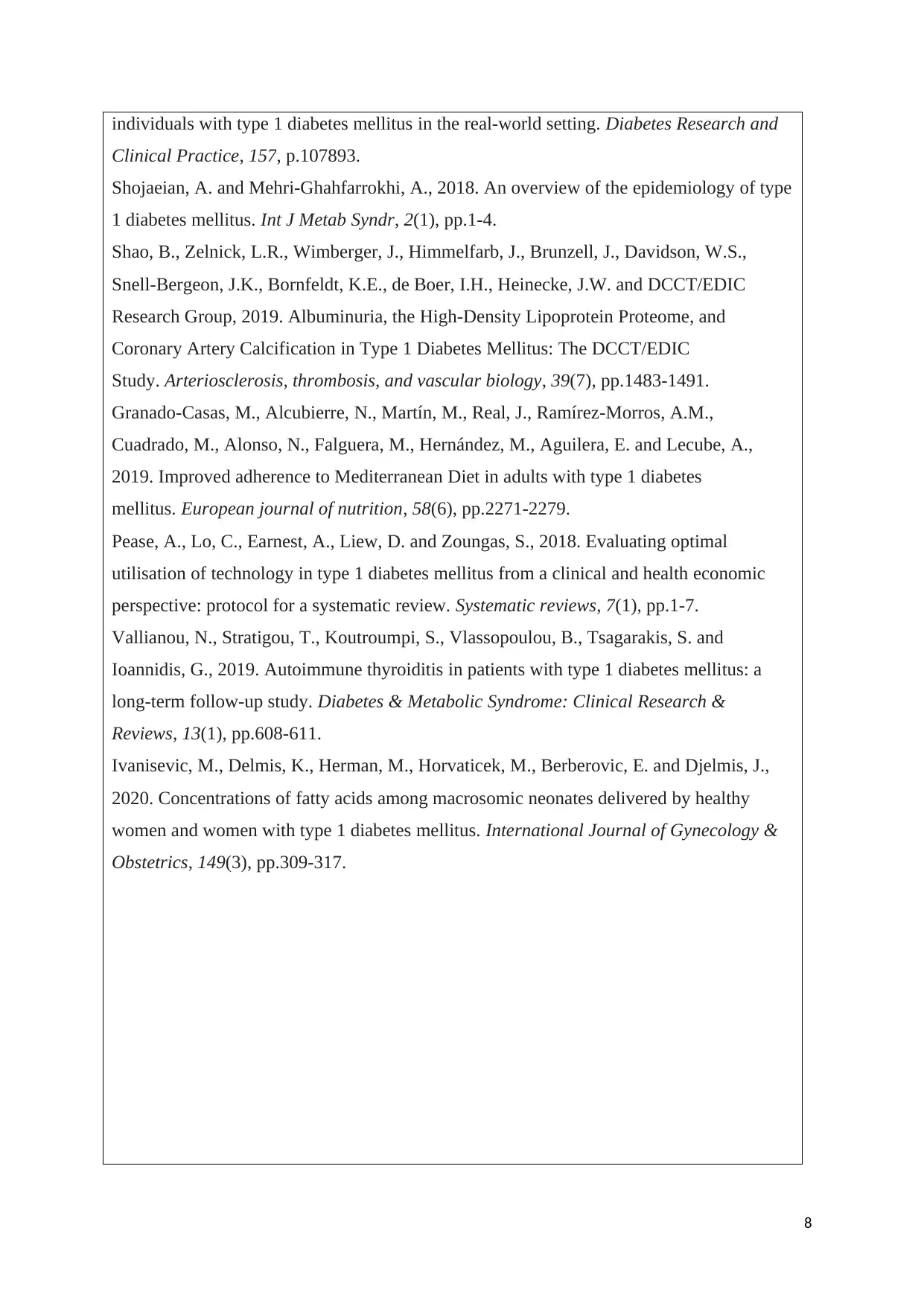
individuals with type 1 diabetes mellitus in the real-world setting. Diabetes Research and
Clinical Practice, 157, p.107893.
Shojaeian, A. and Mehri-Ghahfarrokhi, A., 2018. An overview of the epidemiology of type
1 diabetes mellitus. Int J Metab Syndr, 2(1), pp.1-4.
Shao, B., Zelnick, L.R., Wimberger, J., Himmelfarb, J., Brunzell, J., Davidson, W.S.,
Snell-Bergeon, J.K., Bornfeldt, K.E., de Boer, I.H., Heinecke, J.W. and DCCT/EDIC
Research Group, 2019. Albuminuria, the High-Density Lipoprotein Proteome, and
Coronary Artery Calcification in Type 1 Diabetes Mellitus: The DCCT/EDIC
Study. Arteriosclerosis, thrombosis, and vascular biology, 39(7), pp.1483-1491.
Granado-Casas, M., Alcubierre, N., Martín, M., Real, J., Ramírez-Morros, A.M.,
Cuadrado, M., Alonso, N., Falguera, M., Hernández, M., Aguilera, E. and Lecube, A.,
2019. Improved adherence to Mediterranean Diet in adults with type 1 diabetes
mellitus. European journal of nutrition, 58(6), pp.2271-2279.
Pease, A., Lo, C., Earnest, A., Liew, D. and Zoungas, S., 2018. Evaluating optimal
utilisation of technology in type 1 diabetes mellitus from a clinical and health economic
perspective: protocol for a systematic review. Systematic reviews, 7(1), pp.1-7.
Vallianou, N., Stratigou, T., Koutroumpi, S., Vlassopoulou, B., Tsagarakis, S. and
Ioannidis, G., 2019. Autoimmune thyroiditis in patients with type 1 diabetes mellitus: a
long-term follow-up study. Diabetes & Metabolic Syndrome: Clinical Research &
Reviews, 13(1), pp.608-611.
Ivanisevic, M., Delmis, K., Herman, M., Horvaticek, M., Berberovic, E. and Djelmis, J.,
2020. Concentrations of fatty acids among macrosomic neonates delivered by healthy
women and women with type 1 diabetes mellitus. International Journal of Gynecology &
Obstetrics, 149(3), pp.309-317.
8
Clinical Practice, 157, p.107893.
Shojaeian, A. and Mehri-Ghahfarrokhi, A., 2018. An overview of the epidemiology of type
1 diabetes mellitus. Int J Metab Syndr, 2(1), pp.1-4.
Shao, B., Zelnick, L.R., Wimberger, J., Himmelfarb, J., Brunzell, J., Davidson, W.S.,
Snell-Bergeon, J.K., Bornfeldt, K.E., de Boer, I.H., Heinecke, J.W. and DCCT/EDIC
Research Group, 2019. Albuminuria, the High-Density Lipoprotein Proteome, and
Coronary Artery Calcification in Type 1 Diabetes Mellitus: The DCCT/EDIC
Study. Arteriosclerosis, thrombosis, and vascular biology, 39(7), pp.1483-1491.
Granado-Casas, M., Alcubierre, N., Martín, M., Real, J., Ramírez-Morros, A.M.,
Cuadrado, M., Alonso, N., Falguera, M., Hernández, M., Aguilera, E. and Lecube, A.,
2019. Improved adherence to Mediterranean Diet in adults with type 1 diabetes
mellitus. European journal of nutrition, 58(6), pp.2271-2279.
Pease, A., Lo, C., Earnest, A., Liew, D. and Zoungas, S., 2018. Evaluating optimal
utilisation of technology in type 1 diabetes mellitus from a clinical and health economic
perspective: protocol for a systematic review. Systematic reviews, 7(1), pp.1-7.
Vallianou, N., Stratigou, T., Koutroumpi, S., Vlassopoulou, B., Tsagarakis, S. and
Ioannidis, G., 2019. Autoimmune thyroiditis in patients with type 1 diabetes mellitus: a
long-term follow-up study. Diabetes & Metabolic Syndrome: Clinical Research &
Reviews, 13(1), pp.608-611.
Ivanisevic, M., Delmis, K., Herman, M., Horvaticek, M., Berberovic, E. and Djelmis, J.,
2020. Concentrations of fatty acids among macrosomic neonates delivered by healthy
women and women with type 1 diabetes mellitus. International Journal of Gynecology &
Obstetrics, 149(3), pp.309-317.
8

9
⊘ This is a preview!⊘
Do you want full access?
Subscribe today to unlock all pages.

Trusted by 1+ million students worldwide
1 out of 9
Related Documents
Your All-in-One AI-Powered Toolkit for Academic Success.
+13062052269
info@desklib.com
Available 24*7 on WhatsApp / Email
![[object Object]](/_next/static/media/star-bottom.7253800d.svg)
Unlock your academic potential
Copyright © 2020–2025 A2Z Services. All Rights Reserved. Developed and managed by ZUCOL.





